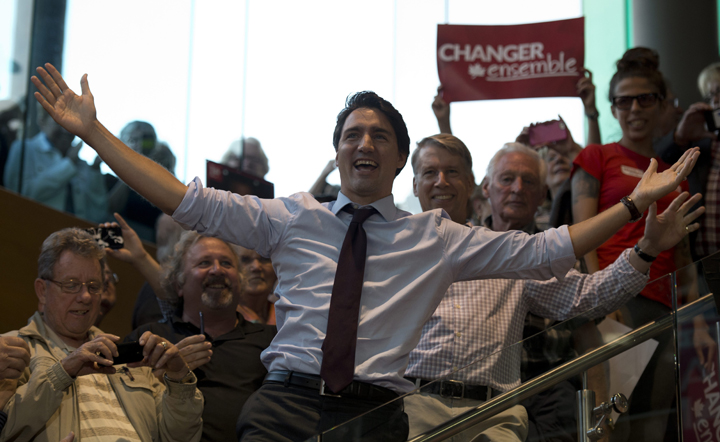The gap between Justin Trudeau’s Liberals and Stephen Harper’s Conservatives is widening by the day, with the latest seat projections showing an excellent chance of a Liberal minority government come Oct. 19.

After overtaking the Conservatives in seat projections last week, the Liberals have gathered momentum in the campaign’s final stretch and are now projected to win 142 seats, up 14 from the last projection just a few days ago.
The Conservatives, who stood at 122 projected seats last week, have fallen to 112, and the NDP, once the campaign front-runners, have also dipped from 84 to 80 seats, continuing a slide that began over a month ago.
“Right now we’re talking about a pretty clear-cut Liberal minority,” said Wilfrid Laurier University politics professor Barry Kay.
NDP seats have been slipping over to the Liberal camp for a while, Kay explained, but for the first time, the Conservatives are now losing major ground to Trudeau.
The Liberals have Ontario to thank for the reversal of fortunes. They are now expected to claim a whopping 72 seats across Canada’s most populous province, compared to 34 for the Conservatives and 15 for the NDP. It is in Ontario that Harper’s camp is “bleeding dramatically” with just days to go before Canadians head to the polls, Kay said.
“The (Liberal) momentum is still going,” he noted. “The NDP has probably hit bottom, if we’re talking specifically in Ontario.”
The seat projections are based on a weighted averaging of polls from firms Ipsos, Ekos, Nanos, Innovative Research, Forum and Angus Reid conducted between Oct. 7 and Oct. 13 and involving over 6,000 respondents.
The NDP is still projected to take 40 seats in their most critical battleground: Quebec. That’s a significant drop from the 58 seats Tom Mulcair’s party captured in 2011’s Orange Wave, but the party is doing extremely well compared to other federal elections past, Kay noted.
- Grocery code: How Ottawa has tried to get Loblaw, Walmart on board
- Alberta to overhaul municipal rules to include sweeping new powers, municipal political parties
- Military judges don’t have divided loyalties, Canada’s top court rules
- Canada, U.S., U.K. lay additional sanctions on Iran over attack on Israel
“It’s really not a terrible election for them.”
Meanwhile, the Conservatives, possibly due to the party’s opposition to the wearing of the niqab during the swearing of the citizenship oath, have found – and maintained – a foothold in Quebec and are projected to take 14 seats there, while the Liberals are also anticipated to make a relatively strong showing with 21 seats. The Bloc Quebecois is projected to win three seats, down from four in 2011.
Even with 142 seats projected to go to the Liberals, the party is still almost 30 seats short of majority territory, Kay said. In order to capture the additional seats needed, he said, the party would need to see dramatic movement in its favour in Quebec or other regions outside of Ontario.





Comments